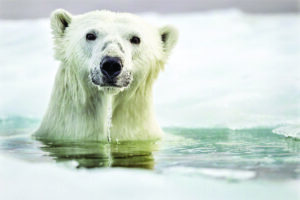By Dr. Beth Leermakers
“Rudolph the red-nosed polar bear” just doesn’t have the same ring to it. Santa has limited options for delivery team members, given his remote location. If Santa hadn’t offered excellent health insurance and retirement benefits, Rudolph and his friends wouldn’t have relocated to the North Pole from the tundra in Greenland. Just for fun, let’s take a peek at the resumes of a few other arctic animals that applied for Santa’s seasonal delivery gig.
Polar Bears. Polar bears are the top predator in the Arctic marine ecosystem. They are found only in the Arctic, with 60 percent living in Canada.

Photo courtesy of blogspot.com
Work experience: Actor/Model for Coca Cola. Proven ability to “work it” for the camera and represent the brand in warm and fuzzy advertisements. Polar bears first appeared in Coke print ads in France in 1922. The photogenic bears began starring in commercials in 1993, appearing in the “Northern Lights” commercial. Polar bears are a natural for the PR responsibilities that are part of the job description for Santa’s helpers.
Skills: Cold tolerance. Polar bears are well suited to survive in extremely cold conditions (down to 40 degrees below zero). Polar bears have two layers of fur, a layer of blubber to keep them warm in the coldest weather, and black skin to absorb the heat. Hollow guard hairs keep their fur from matting when it gets wet. Polar bears are actually more concerned about overheating than getting too cold. Polar bears wouldn’t have to bundle up when delivering gifts to the coldest regions of the world.
Swimming prowess: Polar bears are strong swimmers that can swim for miles and stay underwater for two minutes at a time. Their species name is Ursus maritimus: bears of the sea. Deliveries to islands — or castles with moats — would be no problem for these aquatic athletes.
Fuel efficiency: Polar bears can go 3-4 months without eating. Food (seal fat) is scarce most of the year. Polar bears consume a lot of fat (up to 4.4 pounds a day) between late April and mid-July, building their fat reserves so they can maintain their weight during the lean season.
Polar bears wouldn’t need to stop for a meal while delivering gifts.
Special Honor: Largest terrestrial carnivore, weighing 775-1500 lbs.
Norwhals. Often called unicorns of the sea, these whales with their distinctive ivory tusks (up to 9 feet long, found primarily in males) spend their lives in the Arctic waters of Canada, Greenland, Norway and Russia.
Work experience: Pool maintenance technician for salt water pools. The narwhal tusk is a tooth with millions of nerve endings. Research suggests that this sensory organ allows the whale to detect changes in salt concentrations, indicating that the water is freezing and the whale may become trapped. The Norwhal could be part of Santa’s advance team, detecting ice that is starting to melt and is unsafe for traveling across.
Skills: Deep sea diving. Norwhals can dive about a mile deep and hold their breath for up to 25 minutes. When they need to pop up for air, they take advantage of cracks in the ice. Santa wouldn’t have to take the Channel between England and France.
He could just strap on a SCUBA tank and hold onto a Norwhal to make the channel crossing.
Special honor: One of the world’s most mysterious whales.
Walruses. These adorable, highly social creatures live in the arctic seas, hauling out onto the ice to rest, mate, give birth and nurse their calves.
Work experience: Actor/entertainer at SeaWorld. Walruses are trainable and popular, making them well suited for public appearances and photo sessions with Santa.
Skills: Breaking the ice. The Walrus’ Genus Name — Odobenus — means “Tooth-Walking Sea Horse.” Walruses use their strong, long (up to 3 feet!) ivory tusks as ice axes to haul themselves out of the water. They also use them to break through the ice to create breathing holes. Their tusks could come in handy when Santa needs to climb a slippery roof or break the ice covering a chimney.
Protecting their young: A mother walrus picks up her calf with her flippers and holds it to her chest if it’s threatened, diving into the water to avoid predators. Santa would be safe with mama walruses by his side.
Distinctive characteristic: Walruses have huge appetites. They eat about 3-6 percent of their total body weight per day. For a large, 3700-lb male, that comes out to 111-222 lbs. of food per day. A 2700 lb. female would consume a whopping 81-160 lbs. per day. Adult walruses may eat 3,000 to 6,000 clams in a single meal. Families would have to ramp up the number of snacks they leave for Santa and his team — and take out a second mortgage to buy fresh clams.
Why did reindeer get the job? Caribou (aka reindeer) are well adapted for cold weather and have experience pulling a sled (allowing Santa to carry a bigger load). On Christmas morning, when your gifts show up dry and on time, be thankful the walrus didn’t get the job!
Merry Christmas!
